Viva La Weirdness: Marvel’s Whacked-Out Comics of the Seventies
Essential Defenders, Vol. 1
Essential Killraven
Essential Howard the Duck
Warlock: Special Edition #1-6
Marvel Comics in the seventies found itself in a strange place. The giants of the industry who founded the empire were gone. Kirby went to DC, Ditko left to do his own work, Lee basically got out of comics.
At the same time, underground comix emerged. Talents like R. Crumb and Gilbert Shelton broke new ground in the medium, stressing the personal, the political, and the outrageous.
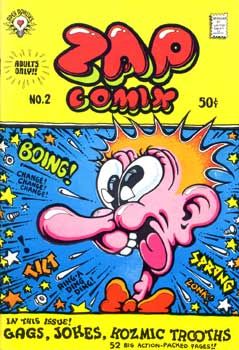
And, as per usual for the comic book industry, financial doom threatened.
Marvel responded in several ways. They froze the status quo on the major titles, spread into other genres (horror, sword and sorcery, science fiction, etc.), and rode an explosion of pop culture nostalgia (reviving Doc Savage, creating the World War Two retro title The Invaders, etc.). They pursued fads like kung fu, blaxploitation, and…um…the Human Fly.
This era of confusion and uncertain boundaries also gave birth to the Whacked-Out Comic. Whacked-Out Comics were those that abused or abandoned the standard superhero comic model. Frequently they were the only personal or interesting books available in the mainstream.
God bless ‘em, Marvel has finally started to put out some of their Whacked-Out Comics in the affordable “Essentials” format.
Essential Defenders, Vol. 1
Hulk not understand.
--The Hulk
The Defenders were a super-team that raised the Marvel keystone idea of “bickering heroes” to new levels. The main trio, Dr. Strange, the Hulk and the Sub-Mariner, were on each other’s nerves nearly all of the time. The Sub-Mariner hated being involved in anything not directly affecting his throne. The Hulk hated never understanding what was going on and just wanted to hit somebody. And Dr. Strange was exasperated trying to keep them in line. Keen.
Better still, it had a supporting cast of heroes unlike other comics. Valkyrie wasn’t a shrinking superheroine who gasped at the sight of violence; she went looking for it. She was neither a shrieking harpy, a “designated girlfriend,” nor was she a creepy fanboy-fantasy sex bomb.
Or Nighthawk, who wore a costume that lived on the corner of Cool Street and Goofy Bastard Avenue.
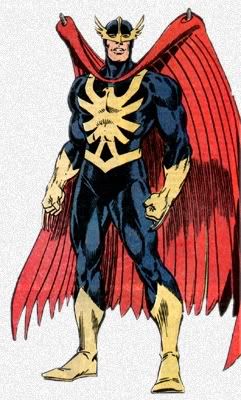
How about his superpowers: low-level super-strength at night, wheelchair-bound normal man by day? Dude, that’s awesome.
During its heyday, the Defenders were the zaniest team in comics. The Avengers fought standard-issue giant menaces like Thanos and got involved in the Kree-Skrull War. The Defenders dealt with mad scientists who placed their heads on gorilla bodies and aliens like Xemnu the Titan, a big fuzzy creature that passed itself off as a children’s show host in order to steal the children of Earth and repopulate his planet.
Originally the team began as an excuse to collect the biggest non-affiliated hitters in the Marvel Universe: the Sub-Mariner, the Hulk, and the Silver Surfer. They fought together in two issues of The Sub-Mariner, then went on their separate ways.
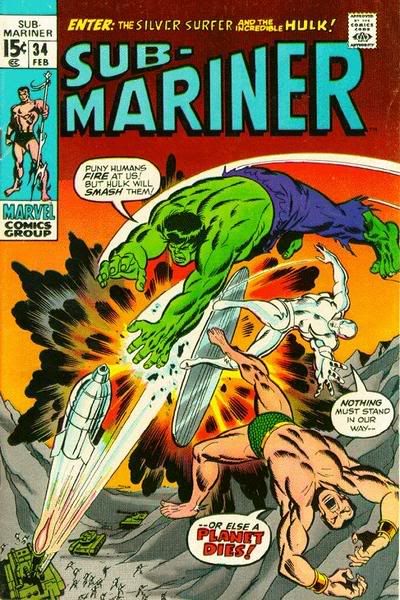
Fans went nuts over the ad hoc team, and lo, an ongoing series was born. (Thankfully for us all, political considerations in Marvel led to the replacement of the boring and preachy Surfer with the far more fun and well-mustachioed Dr. Strange.)
The issues written by Roy Thomas that predate the launch of the Defenders series proper are decent. The issues written by Steve Englehart, starting with Defenders #1, are a whole lot of fun. Essential Defenders Volume One contains mad magicians, angry two-headed gods, and the first big summer crossover in comics history, the loopy "Avengers-Defenders War."
What set The Defenders apart was the sense that anything could happen at any time, and often did. A mad magician powered by the smoke from “strong Jamaican incense” lays waste to the team? Sure. A fluffy kiddie-show host is actually a vicious alien? Why not?

Reading the collection, you can almost hear the creative team yelling “HEEEE-WACK!” They stomped the accelerator to the floor and steered the book right into the heart of the sun. Essential Defenders Volume One shows the Whacked-Out Comic vibe beginning to influence mainstream superheroes. And it is good.
Volume One doesn’t reach the truly Whacked-Out issues of the series, which came with the legendary Steve Gerber-scripted run. Those issues fall just outside the reach of the book. If and when Marvel publishes Essential Defenders Volume Two, you’d best not stand between me and the nearest comic book store.
What makes the Gerber run so worthwhile?
Four words, my brothers and sisters. Four simple words: "Elf with a Gun."
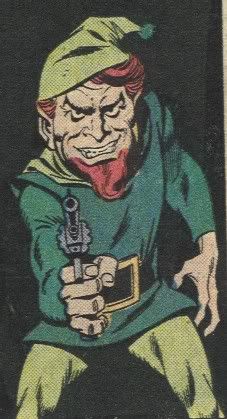
Essential Defenders Volume One is highly recommended for those who want light, snappy superhero comic entertainment. For those who like their comics heavy or serious, never mind.
Essential Killraven
Thank you. Thank you for buying this.
--Clerk at my local comic shop.
The clerk at my comic shop thanked me for buying Essential Killraven. Yep. Really. Her thanks were not those of a fellow fan who was pleased someone else was into the book. Nor was she being sarcastic. No, she was thankful that some damn fool would cough up the green to buy this, the quintessential inessential “Essential.” She was afraid the book was wasted money for the store.
Silly person. Who could resist? Look at what Killraven offers:
--A painfully obscure character whose series ran from 1973-1976, and whose story continued in a graphic novel in 1983, a one-shot in 2001, and an ignored miniseries in 2002. Even I, a dedicated comic book dork, had no idea who he was.
--A post-apocalyptic setting "inspired" by H.G. Wells. The Killraven stories were originally entitled War of the Worlds and took place in the aftermath of the Martians’ second invasion, which took place in 2001 (after the aliens had mastered antibiotics, I guess).
--A hero with a ludicrous "tough guy" name reminiscent of bad fantasy novels. Said hero was clad in leather shorts, suspenders and thigh boots. And nothing else.
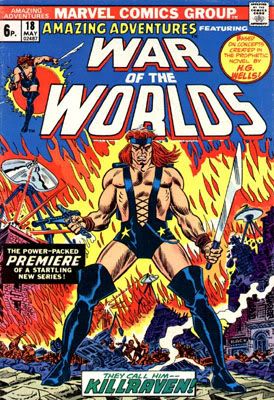
--A ham-fisted fusion of sci-fi with sword and sorcery akin to the contents of Heavy Metal Magazine, minus the nudity.
--Exotic settings like Battle Creek, Michigan, Gary, Indiana, and the swamps of Florida.
--A drunken raccoon.
--And a giant stone head of Howard Cosell with flaming horns.
The book sells itself!
Given my love of weird seventies Marvel-iana, I had to have it.
Should anyone else buy it? Uh...
The series went through a couple of old-timey Marvel Comics hands in its first three issues. Writers Gerry Conway, Roy Thomas and Marv Wolfman all had a turn at Killraven before the book settled on Don McGregor for the rest of the run (with the occasional fill-in issues by Bill Mantlo).
The first issue was drawn by the combination of Neal Adams and Howard Chaykin, had a fill-in or two, then settled into a groove with Herb Trimpe for five issues. The rest of the series, and the bulk of the Essential volume, was drawn by a young P. Craig Russell.
The early issues were standard seventies sci-fi action fare. War of the Worlds began much like a Planet of the Apes comic or other post-apocalyptic story as told by Marvel Comics: big action, lots of monsters, and the promise that Killraven was the potential savior of the world.
Once the regular team of McGregor and Russell took over, Killraven took a step…hmm…I wouldn’t call it a step forward. More of a step sideways.
I could dance around the point, but instead I’ll just say it: McGregor’s scripting was a mess. Over-written to a level seldom seen even in comics, Killraven stories never used ten words when they could use thirty. McGregor never described something as “red” when he could describe it as “the searing crimson of the Martian plains.” Imagine pages upon pages of such over-ripe prose and you’ll have a decent impression of Essential Killraven.
The captions were either purple and hyperbolic in the manner of Stan Lee or excruciating in the manner of a bad fantasy novel straining to be poetic. Moreover, the tone of dialogue shifted madly within issues, even within pages. McGregor felt the need to break up the usually portentous dialogue with “funny banter” between his characters. This “banter” must have been an effort to inject humanity into the story. Instead it felt like bad sitcom or action movie dialogue shoehorned into a “laser beams and fairies” story.
Killraven often reads like a half-thought out project. The series takes place between 2016 and 2020, and thus all of the main characters were born before the Martian invasion of 2001. Any adult in the world of Killraven would have memories of pre-invasion Earth, unless these memories were specifically wiped by the aliens. Yet throughout the series, there were stories that could work only if nobody remembered the times before the Martians.
One story set in Battle Creek climaxed with the “shock ending” that the army of zealots fighting Killraven and his buddies were protecting a horde of cereal box toys. A cheap and Twilight Zone-y standard sci-fi “twist,” right? But the story was set in 2018. The characters were old enough to have known the true meaning of a Cap’n Crunch whistle.
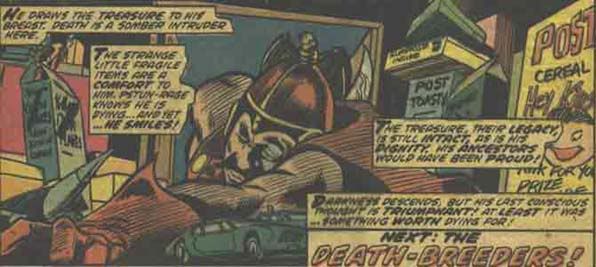
Another issue surrounded a cult that worshipped at the ruins of a giant yellow arch. Yep, it was a McDonald’s sign half-buried in rubble. Again, considering how many adults were in the cult, you’d think at least one of them would remember the most ubiquitous restaurant in the history of the human race, even eighteen years after the devastation.
It seemed more that the writers had decided that War of the Worlds was about a post-apocalyptic world and ran with the clichés of that genre, rather than stop to think about what a world less than twenty years after a planet-wide disaster would look like.
Though McGregor’s writing was poor in general, it contained a few good elements. Killraven’s supporting cast, built by Roy Thomas and Gerry Conway, stuck to the standard clichéd lines: The Great White Hero, the Wisecracking Black Sidekick, the Scientist Babe, the Herculean Man-Child, and the Noble Indian Tracker. McGregor’s finest achievement was taking this stock cast into unexpected directions.
For example, the Scientist Babe didn’t fall for the Great White Hero. The series’ best and most human subplot was the gradual birth of love between her and the Wisecracking Black Sidekick. As a result, said Wisecracking Sidekick grew as a man over the course of the series. Also, the Noble Indian Tracker proved to be a selfish and self-righteous jerk. The Great White Hero had no idea what he was doing most of the time beyond “I wanna kill Martians,” a flaw noted by the Scientist Babe. Not characters of Shakespearean depth, but a cut above normal action-hero fare.
What about the art?
Here we come to Killraven’s great strength. Russell did an amazing job throughout his run on the series.* The quality of the art fluctuated with the inkers, but even under poor inking, you can see that P. Craig fellow penciled some right pretty pictures. He drew all manner of fantastical things in an intricate and ornate style. Moreover, he experimented with alternative layouts and created arresting page designs.
Essential Killraven is one of the most attractive and visually-striking books in the Essentials lineup. Leafing through the latter half of the book, you can find an amazing image every few pages. The book even experimented with lettering by using a sans-serif typographical font for some of the captions. Keen.
By the end of the volume, Killraven no longer feels like a Planet of the Apes-knockoff post-apocalyptic tale. Instead it feels like a mediocre science fiction novel. It has a couple of neat ideas, a bushel of terrible ideas, and some of the prettiest comic book art of the seventies.
Essential Killraven is recommended only as a historical curiosity and for fans of fantasy-style art. Otherwise, take a pass. It’s been forgotten for a good reason.
-------------
* The art in the handful non-Russell issues was standard-issue superhero art of varying skill. The Adams/Chaykin art was excellent and exciting. The Rich Buckler and Gene Colan art got the job done. To my surprise, Herb Trimpe, an artist I’ve never liked, did a fine job on his seven issues.
Essential Howard the Duck
Waaaugh!
--Howard the Duck
Mainstream comics are designed to be made with roughly interchangeable parts. Lose an inker, find an inker. Writer becomes a pain in the butt? Replace him with someone more pliable. An author’s voice might sneak through a little bit once in a while, muted and distorted by the necessities of the medium. However, there are exceptions. In the late seventies, Marvel put out a comic where the author’s voice blared loudly: Howard the Duck.
The Essential Howard the Duck reprints the issues written by the Duck’s creator, Steve Gerber.* The book is both easier and harder to explain then most comics. Howard was an intelligent talking duck from another dimension trapped on Earth and trying to get by in modern-day (late seventies) Cleveland.
For his first few stories, back-up short stories in Man-Thing collections, Howard encountered villain parodies like Garko the Man-Frog and the vampiric Hellcow.** Once graduating to his own series, Howard and his comic became a vehicle for Gerber’s observations on society and on himself.
The series ranged from national politics (Howard runs for president in 1976 under the slogan “Get Down, America”) to personal tragedies (Howard has a nervous breakdown in a story that felt like the fruits of painful experience).
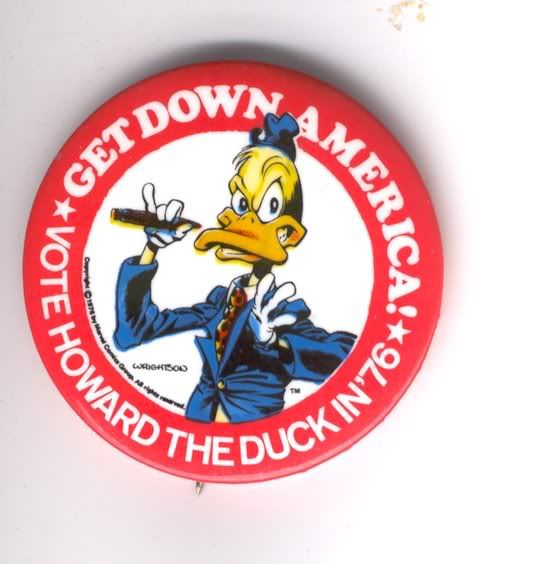
It enjoyed a healthy dose of absurdity (a giant salt shaker with the arms and legs of a gorilla appears out of nowhere and seasons Howard) and the foolishness of everyday life (the dreaded Kidney Lady, who turns up time and again, accusing Howard of trying to steal her kidneys).
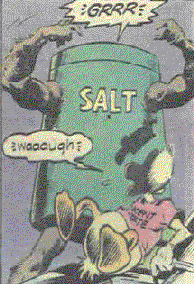

The book, in short, was a lot of fun and stands as a highlight of the Whacked-Out Comic era.
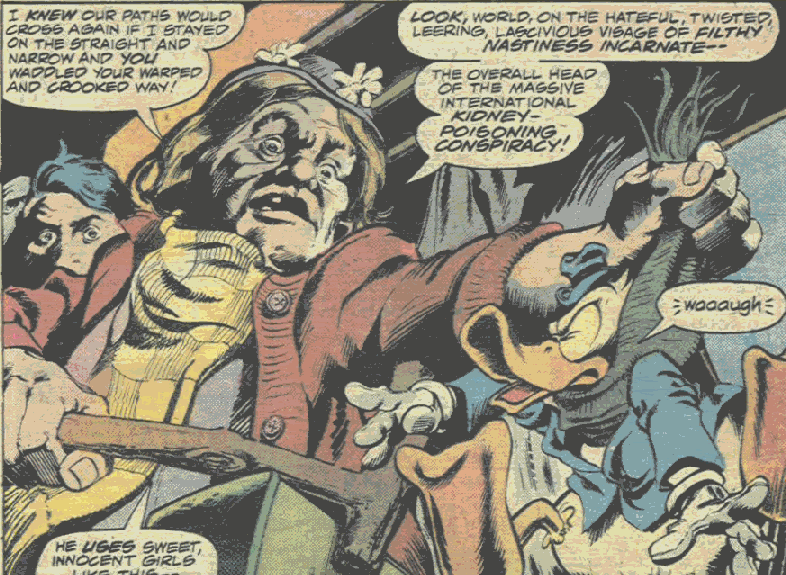
Not to say the book is flawless. The primary sin of Howard the Duck was an indulgence in over-identification.
Howard described himself as having the potential to be a great scholar, but easily bored and scared of being stuck into a single category. So, he explained, he got his education on the streets. (Yes, Gerber actually used the phrase “got his education on the streets.”) The Duck maintained a superior attitude towards humanity while recognizing his own ridiculousness. He was mentally fragile and embittered towards the world. And he always stood apart from humanity, among them but never of them.
This combination of cloaked self-aggrandizement and naked self-pity exploded off the page as Gerber’s image of himself. Howard became an author proxy to a degree that was almost embarrassing at times.
Yet this intense personal flavor is most of what makes Howard worthwhile. Even when the comic dabbled in bitter-crank-railing-against-the-world territory, Howard the Duck was inventive and passionate. Few major-publisher comics are either. Fewer still manage both and remain fun to read.
Gene Colan provided art for the overwhelming majority of the volume. As was normal for Colan, the work is beautiful and fluid, capturing both motion and detail brilliantly. His style seldom seemed to fit well with super-heroes; in Howard the Duck he found an excellent outlet for his talents. (His work in another Marvel series of the seventies, Tomb of Dracula, was even more impressive. Dammit, Colan is one of the under-rated greats of the medium.)
The Essential Howard the Duck is excellent and well worth your comic-buyin’ dollar.
----------------------
* When Howard the Duck became a big success, Gerber and Marvel entered into legal fights over ownership of the character. Marvel won the suit, Gerber left Marvel, and the Duck ended up in the hands of another writer. From a reader’s perspective, the results of the suit were irrelevant. Gerber was Howard and Howard was Gerber. Once the title lost its author, it faded into obscurity and died. Yep, it was a landmark case in the issue of creators’ rights in comics.
** Yes, that’s right, Howard’s early appearances were in Giant-Sized Man-Thing. I’m resisting the urge to make a joke involving the phrase “I got one right here!” The temptation is strong.
Oh, hell with it.
“I got a number one Giant-Size Man-Thing right here, baby!”
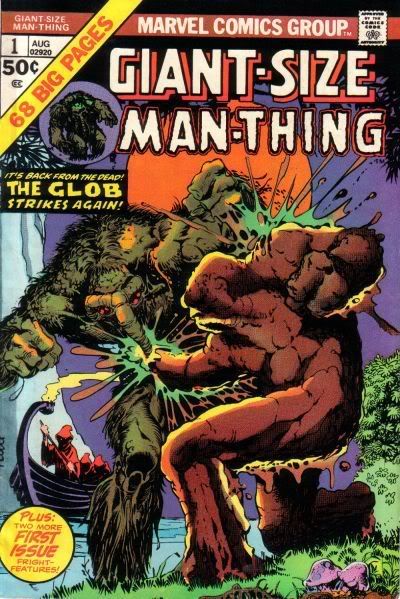
Hee.
Warlock: Special Edition #1-6
“My life has been a failure. I welcome its end."
--Adam Warlock’s last words
Not available in an Essential volume yet, I feel I have to round out these reviews with a mention the great Whacked-Out Comic epic: Jim Starlin’s Warlock.
The Starlin Warlock stories ran through a few issues of Strange Tales, a brief revival of the series Warlock, a single issue of Marvel Team-Up, an Avengers Annual, and finally Marvel Two-in-One Annual. Phew.
They’ve been collected and reprinted a couple of times. I recently scored a collection of these stories printed as a six-issue miniseries by Marvel in the early eighties, Warlock: Special Edition. With luck, they might reprint the stories in an Essential volume. I hope.
An important variety of the Whacked-Out Comic shoots for the big topics like Life, Death, Truth, Justice, and other Capitalized Words. Warlock is one of the premiere examples of this treacherous approach.
Any book, comic or otherwise, that deals with Life, Death, Truth, Justice, and other Capitalized Words takes an enormous risk. A hint too much action and it looks like the Capitalized Words are only set dressing. A hint too much brooding and the books become dull. Too narrow a perspective makes them pompous and pretentious. To wide a perspective makes them diffuse and unsatisfying.
Starlin produced a series that skimmed the borders of insufferable pretension and reached levels of greatness seldom seen in superhero funnybooks. He combined Big Action with Big Themes to make one hell of a Big Comic.
The character Adam Warlock began in an issue of the Fantastic Four as a simple variation on the Frankenstein story. A group of evil geniuses create the perfect cosmic man in a plot to conquer the world. Said perfect cosmic man, dubbed “Him,” recognized the scientists for villains and flew off. He bummed around the Marvel Universe for a while, a character looking for a hook.
Eventually a hook was found. Through a long series of strange circumstances I won’t bother to relate, the artificial man was given the name Adam Warlock, a “mysterious soul gem” atop his brow, and protectorship of a parallel Earth on the opposite side of the sun. Warlock was also saddled with an absurd Christ parallel that culminated in his condemnation, crucifixion, and resurrection. Yes, really.
Sales on this "Jesus Christ, Superhero" comic were poor, and the character disappeared into limbo. (I hope to score a copy of this run. It’s gotta be weird.)
Jim Starlin brought the character back in Strange Tales #178 (February 1975) and immediately plunged Warlock into another story with Big Time Themes. Starlin’s Warlock stories began and ended with long story arcs defined by their villains: the Magus and Thanos.
The latter story is the most famous, as its legacy carried over into the nineties. However, the former is more far-reaching and much more worth reading.
Warlock encounters the Church of Universal Truth, a faith murdering its way across the cosmos in the name of peace and love. Shortly thereafter, the god of the religion, the Magus, appears to him. The Magus tells Warlock that the two of them are one and the same person. Warlock proceeds anyway and lays siege to the Church. Soon he discovers the Magus was right, and that in the near future, Warlock would be driven insane and changed into the mad god.
Throughout the story, Warlock had to face unpleasant truths. He came to see how his own nature would lead him to become such a monster. He had to ally himself with the arch-villain Thanos. And he confronted the difficulty of doing what was right when neither choice before him could possibly be considered "right."
When the Magus story began, he discovered that his soul gem could strip away the soul from a person and trap it forever. Worse, the gem hungered for more souls. During a desperate battle, Thanos implored Warlock to use the soul gem to steal the souls of the thousands of warriors between them and the Magus. Warlock refused, declaring the gem and its use to be evil.
Thanos replied, "Fine sentiments, my golden saint, but has it occurred to you just who will pay for your lofty convictions? You? No! It will be the millions of people you shall enslave as the Magus, who will pay! It will be the thousand worlds your Universal Church of Truth conquers who shall pay for your high moral standards…"
Knowing that Thanos told the truth, Warlock chose the lesser of two great evils and stole the souls from the men in their way. Shortly thereafter, he destroyed his own future and killed a future version of himself to prevent the Magus from ever existing. Again and again, Warlock was forced commit evil deeds to defeat larger evils, and the toll wore on him.
The stories culminated in Thanos’s attempt at destroying the stars to appease his beloved, Death itself. Along the way, Warlock’s supporting cast is murdered by Thanos. Warlock himself dies at his own hands, exactly as shown in the earlier Magus story. Finally Warlock returns from the dead for a few moments to turn Thanos to stone, ending both of their stories forever.*
Given how superheroes and supervillains either escape death or return from the dead with such frequency as to make dying a joke, the seriousness of death in the Warlock stories is shocking and adds a rare heft to a superhero tale.
The story uses obvious symbolism to make its points, and yet despite this "rain of anvils," the story works. Warlock never fails to be entertaining as it delivers its points. Big Themes are much easier to swallow when candy-coated in Big Soopahero Action.
By the way, the Magus has the kickin-est afro in comic book history. I’m sorry, he does. No debates.
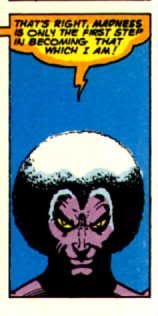
Highly recommended for any and all comics fans. Whacked-Out Comics at their finest.
----------------
* By which I mean “for about fifteen or twenty years.” I am talking about Marvel Comics here.
Essential Killraven
Essential Howard the Duck
Warlock: Special Edition #1-6
Marvel Comics in the seventies found itself in a strange place. The giants of the industry who founded the empire were gone. Kirby went to DC, Ditko left to do his own work, Lee basically got out of comics.
At the same time, underground comix emerged. Talents like R. Crumb and Gilbert Shelton broke new ground in the medium, stressing the personal, the political, and the outrageous.

And, as per usual for the comic book industry, financial doom threatened.
Marvel responded in several ways. They froze the status quo on the major titles, spread into other genres (horror, sword and sorcery, science fiction, etc.), and rode an explosion of pop culture nostalgia (reviving Doc Savage, creating the World War Two retro title The Invaders, etc.). They pursued fads like kung fu, blaxploitation, and…um…the Human Fly.
This era of confusion and uncertain boundaries also gave birth to the Whacked-Out Comic. Whacked-Out Comics were those that abused or abandoned the standard superhero comic model. Frequently they were the only personal or interesting books available in the mainstream.
God bless ‘em, Marvel has finally started to put out some of their Whacked-Out Comics in the affordable “Essentials” format.
Essential Defenders, Vol. 1
Hulk not understand.
--The Hulk
The Defenders were a super-team that raised the Marvel keystone idea of “bickering heroes” to new levels. The main trio, Dr. Strange, the Hulk and the Sub-Mariner, were on each other’s nerves nearly all of the time. The Sub-Mariner hated being involved in anything not directly affecting his throne. The Hulk hated never understanding what was going on and just wanted to hit somebody. And Dr. Strange was exasperated trying to keep them in line. Keen.
Better still, it had a supporting cast of heroes unlike other comics. Valkyrie wasn’t a shrinking superheroine who gasped at the sight of violence; she went looking for it. She was neither a shrieking harpy, a “designated girlfriend,” nor was she a creepy fanboy-fantasy sex bomb.
Or Nighthawk, who wore a costume that lived on the corner of Cool Street and Goofy Bastard Avenue.

How about his superpowers: low-level super-strength at night, wheelchair-bound normal man by day? Dude, that’s awesome.
During its heyday, the Defenders were the zaniest team in comics. The Avengers fought standard-issue giant menaces like Thanos and got involved in the Kree-Skrull War. The Defenders dealt with mad scientists who placed their heads on gorilla bodies and aliens like Xemnu the Titan, a big fuzzy creature that passed itself off as a children’s show host in order to steal the children of Earth and repopulate his planet.
Originally the team began as an excuse to collect the biggest non-affiliated hitters in the Marvel Universe: the Sub-Mariner, the Hulk, and the Silver Surfer. They fought together in two issues of The Sub-Mariner, then went on their separate ways.

Fans went nuts over the ad hoc team, and lo, an ongoing series was born. (Thankfully for us all, political considerations in Marvel led to the replacement of the boring and preachy Surfer with the far more fun and well-mustachioed Dr. Strange.)
The issues written by Roy Thomas that predate the launch of the Defenders series proper are decent. The issues written by Steve Englehart, starting with Defenders #1, are a whole lot of fun. Essential Defenders Volume One contains mad magicians, angry two-headed gods, and the first big summer crossover in comics history, the loopy "Avengers-Defenders War."
What set The Defenders apart was the sense that anything could happen at any time, and often did. A mad magician powered by the smoke from “strong Jamaican incense” lays waste to the team? Sure. A fluffy kiddie-show host is actually a vicious alien? Why not?

Reading the collection, you can almost hear the creative team yelling “HEEEE-WACK!” They stomped the accelerator to the floor and steered the book right into the heart of the sun. Essential Defenders Volume One shows the Whacked-Out Comic vibe beginning to influence mainstream superheroes. And it is good.
Volume One doesn’t reach the truly Whacked-Out issues of the series, which came with the legendary Steve Gerber-scripted run. Those issues fall just outside the reach of the book. If and when Marvel publishes Essential Defenders Volume Two, you’d best not stand between me and the nearest comic book store.
What makes the Gerber run so worthwhile?
Four words, my brothers and sisters. Four simple words: "Elf with a Gun."

Essential Defenders Volume One is highly recommended for those who want light, snappy superhero comic entertainment. For those who like their comics heavy or serious, never mind.
Essential Killraven
Thank you. Thank you for buying this.
--Clerk at my local comic shop.
The clerk at my comic shop thanked me for buying Essential Killraven. Yep. Really. Her thanks were not those of a fellow fan who was pleased someone else was into the book. Nor was she being sarcastic. No, she was thankful that some damn fool would cough up the green to buy this, the quintessential inessential “Essential.” She was afraid the book was wasted money for the store.
Silly person. Who could resist? Look at what Killraven offers:
--A painfully obscure character whose series ran from 1973-1976, and whose story continued in a graphic novel in 1983, a one-shot in 2001, and an ignored miniseries in 2002. Even I, a dedicated comic book dork, had no idea who he was.
--A post-apocalyptic setting "inspired" by H.G. Wells. The Killraven stories were originally entitled War of the Worlds and took place in the aftermath of the Martians’ second invasion, which took place in 2001 (after the aliens had mastered antibiotics, I guess).
--A hero with a ludicrous "tough guy" name reminiscent of bad fantasy novels. Said hero was clad in leather shorts, suspenders and thigh boots. And nothing else.

--A ham-fisted fusion of sci-fi with sword and sorcery akin to the contents of Heavy Metal Magazine, minus the nudity.
--Exotic settings like Battle Creek, Michigan, Gary, Indiana, and the swamps of Florida.
--A drunken raccoon.
--And a giant stone head of Howard Cosell with flaming horns.
The book sells itself!
Given my love of weird seventies Marvel-iana, I had to have it.
Should anyone else buy it? Uh...
The series went through a couple of old-timey Marvel Comics hands in its first three issues. Writers Gerry Conway, Roy Thomas and Marv Wolfman all had a turn at Killraven before the book settled on Don McGregor for the rest of the run (with the occasional fill-in issues by Bill Mantlo).
The first issue was drawn by the combination of Neal Adams and Howard Chaykin, had a fill-in or two, then settled into a groove with Herb Trimpe for five issues. The rest of the series, and the bulk of the Essential volume, was drawn by a young P. Craig Russell.
The early issues were standard seventies sci-fi action fare. War of the Worlds began much like a Planet of the Apes comic or other post-apocalyptic story as told by Marvel Comics: big action, lots of monsters, and the promise that Killraven was the potential savior of the world.
Once the regular team of McGregor and Russell took over, Killraven took a step…hmm…I wouldn’t call it a step forward. More of a step sideways.
I could dance around the point, but instead I’ll just say it: McGregor’s scripting was a mess. Over-written to a level seldom seen even in comics, Killraven stories never used ten words when they could use thirty. McGregor never described something as “red” when he could describe it as “the searing crimson of the Martian plains.” Imagine pages upon pages of such over-ripe prose and you’ll have a decent impression of Essential Killraven.
The captions were either purple and hyperbolic in the manner of Stan Lee or excruciating in the manner of a bad fantasy novel straining to be poetic. Moreover, the tone of dialogue shifted madly within issues, even within pages. McGregor felt the need to break up the usually portentous dialogue with “funny banter” between his characters. This “banter” must have been an effort to inject humanity into the story. Instead it felt like bad sitcom or action movie dialogue shoehorned into a “laser beams and fairies” story.
Killraven often reads like a half-thought out project. The series takes place between 2016 and 2020, and thus all of the main characters were born before the Martian invasion of 2001. Any adult in the world of Killraven would have memories of pre-invasion Earth, unless these memories were specifically wiped by the aliens. Yet throughout the series, there were stories that could work only if nobody remembered the times before the Martians.
One story set in Battle Creek climaxed with the “shock ending” that the army of zealots fighting Killraven and his buddies were protecting a horde of cereal box toys. A cheap and Twilight Zone-y standard sci-fi “twist,” right? But the story was set in 2018. The characters were old enough to have known the true meaning of a Cap’n Crunch whistle.

Another issue surrounded a cult that worshipped at the ruins of a giant yellow arch. Yep, it was a McDonald’s sign half-buried in rubble. Again, considering how many adults were in the cult, you’d think at least one of them would remember the most ubiquitous restaurant in the history of the human race, even eighteen years after the devastation.
It seemed more that the writers had decided that War of the Worlds was about a post-apocalyptic world and ran with the clichés of that genre, rather than stop to think about what a world less than twenty years after a planet-wide disaster would look like.
Though McGregor’s writing was poor in general, it contained a few good elements. Killraven’s supporting cast, built by Roy Thomas and Gerry Conway, stuck to the standard clichéd lines: The Great White Hero, the Wisecracking Black Sidekick, the Scientist Babe, the Herculean Man-Child, and the Noble Indian Tracker. McGregor’s finest achievement was taking this stock cast into unexpected directions.
For example, the Scientist Babe didn’t fall for the Great White Hero. The series’ best and most human subplot was the gradual birth of love between her and the Wisecracking Black Sidekick. As a result, said Wisecracking Sidekick grew as a man over the course of the series. Also, the Noble Indian Tracker proved to be a selfish and self-righteous jerk. The Great White Hero had no idea what he was doing most of the time beyond “I wanna kill Martians,” a flaw noted by the Scientist Babe. Not characters of Shakespearean depth, but a cut above normal action-hero fare.
What about the art?
Here we come to Killraven’s great strength. Russell did an amazing job throughout his run on the series.* The quality of the art fluctuated with the inkers, but even under poor inking, you can see that P. Craig fellow penciled some right pretty pictures. He drew all manner of fantastical things in an intricate and ornate style. Moreover, he experimented with alternative layouts and created arresting page designs.
Essential Killraven is one of the most attractive and visually-striking books in the Essentials lineup. Leafing through the latter half of the book, you can find an amazing image every few pages. The book even experimented with lettering by using a sans-serif typographical font for some of the captions. Keen.
By the end of the volume, Killraven no longer feels like a Planet of the Apes-knockoff post-apocalyptic tale. Instead it feels like a mediocre science fiction novel. It has a couple of neat ideas, a bushel of terrible ideas, and some of the prettiest comic book art of the seventies.
Essential Killraven is recommended only as a historical curiosity and for fans of fantasy-style art. Otherwise, take a pass. It’s been forgotten for a good reason.
-------------
* The art in the handful non-Russell issues was standard-issue superhero art of varying skill. The Adams/Chaykin art was excellent and exciting. The Rich Buckler and Gene Colan art got the job done. To my surprise, Herb Trimpe, an artist I’ve never liked, did a fine job on his seven issues.
Essential Howard the Duck
Waaaugh!
--Howard the Duck
Mainstream comics are designed to be made with roughly interchangeable parts. Lose an inker, find an inker. Writer becomes a pain in the butt? Replace him with someone more pliable. An author’s voice might sneak through a little bit once in a while, muted and distorted by the necessities of the medium. However, there are exceptions. In the late seventies, Marvel put out a comic where the author’s voice blared loudly: Howard the Duck.
The Essential Howard the Duck reprints the issues written by the Duck’s creator, Steve Gerber.* The book is both easier and harder to explain then most comics. Howard was an intelligent talking duck from another dimension trapped on Earth and trying to get by in modern-day (late seventies) Cleveland.
For his first few stories, back-up short stories in Man-Thing collections, Howard encountered villain parodies like Garko the Man-Frog and the vampiric Hellcow.** Once graduating to his own series, Howard and his comic became a vehicle for Gerber’s observations on society and on himself.
The series ranged from national politics (Howard runs for president in 1976 under the slogan “Get Down, America”) to personal tragedies (Howard has a nervous breakdown in a story that felt like the fruits of painful experience).

It enjoyed a healthy dose of absurdity (a giant salt shaker with the arms and legs of a gorilla appears out of nowhere and seasons Howard) and the foolishness of everyday life (the dreaded Kidney Lady, who turns up time and again, accusing Howard of trying to steal her kidneys).


The book, in short, was a lot of fun and stands as a highlight of the Whacked-Out Comic era.

Not to say the book is flawless. The primary sin of Howard the Duck was an indulgence in over-identification.
Howard described himself as having the potential to be a great scholar, but easily bored and scared of being stuck into a single category. So, he explained, he got his education on the streets. (Yes, Gerber actually used the phrase “got his education on the streets.”) The Duck maintained a superior attitude towards humanity while recognizing his own ridiculousness. He was mentally fragile and embittered towards the world. And he always stood apart from humanity, among them but never of them.
This combination of cloaked self-aggrandizement and naked self-pity exploded off the page as Gerber’s image of himself. Howard became an author proxy to a degree that was almost embarrassing at times.
Yet this intense personal flavor is most of what makes Howard worthwhile. Even when the comic dabbled in bitter-crank-railing-against-the-world territory, Howard the Duck was inventive and passionate. Few major-publisher comics are either. Fewer still manage both and remain fun to read.
Gene Colan provided art for the overwhelming majority of the volume. As was normal for Colan, the work is beautiful and fluid, capturing both motion and detail brilliantly. His style seldom seemed to fit well with super-heroes; in Howard the Duck he found an excellent outlet for his talents. (His work in another Marvel series of the seventies, Tomb of Dracula, was even more impressive. Dammit, Colan is one of the under-rated greats of the medium.)
The Essential Howard the Duck is excellent and well worth your comic-buyin’ dollar.
----------------------
* When Howard the Duck became a big success, Gerber and Marvel entered into legal fights over ownership of the character. Marvel won the suit, Gerber left Marvel, and the Duck ended up in the hands of another writer. From a reader’s perspective, the results of the suit were irrelevant. Gerber was Howard and Howard was Gerber. Once the title lost its author, it faded into obscurity and died. Yep, it was a landmark case in the issue of creators’ rights in comics.
** Yes, that’s right, Howard’s early appearances were in Giant-Sized Man-Thing. I’m resisting the urge to make a joke involving the phrase “I got one right here!” The temptation is strong.
Oh, hell with it.
“I got a number one Giant-Size Man-Thing right here, baby!”

Hee.
Warlock: Special Edition #1-6
“My life has been a failure. I welcome its end."
--Adam Warlock’s last words
Not available in an Essential volume yet, I feel I have to round out these reviews with a mention the great Whacked-Out Comic epic: Jim Starlin’s Warlock.
The Starlin Warlock stories ran through a few issues of Strange Tales, a brief revival of the series Warlock, a single issue of Marvel Team-Up, an Avengers Annual, and finally Marvel Two-in-One Annual. Phew.
They’ve been collected and reprinted a couple of times. I recently scored a collection of these stories printed as a six-issue miniseries by Marvel in the early eighties, Warlock: Special Edition. With luck, they might reprint the stories in an Essential volume. I hope.
An important variety of the Whacked-Out Comic shoots for the big topics like Life, Death, Truth, Justice, and other Capitalized Words. Warlock is one of the premiere examples of this treacherous approach.
Any book, comic or otherwise, that deals with Life, Death, Truth, Justice, and other Capitalized Words takes an enormous risk. A hint too much action and it looks like the Capitalized Words are only set dressing. A hint too much brooding and the books become dull. Too narrow a perspective makes them pompous and pretentious. To wide a perspective makes them diffuse and unsatisfying.
Starlin produced a series that skimmed the borders of insufferable pretension and reached levels of greatness seldom seen in superhero funnybooks. He combined Big Action with Big Themes to make one hell of a Big Comic.
The character Adam Warlock began in an issue of the Fantastic Four as a simple variation on the Frankenstein story. A group of evil geniuses create the perfect cosmic man in a plot to conquer the world. Said perfect cosmic man, dubbed “Him,” recognized the scientists for villains and flew off. He bummed around the Marvel Universe for a while, a character looking for a hook.
Eventually a hook was found. Through a long series of strange circumstances I won’t bother to relate, the artificial man was given the name Adam Warlock, a “mysterious soul gem” atop his brow, and protectorship of a parallel Earth on the opposite side of the sun. Warlock was also saddled with an absurd Christ parallel that culminated in his condemnation, crucifixion, and resurrection. Yes, really.
Sales on this "Jesus Christ, Superhero" comic were poor, and the character disappeared into limbo. (I hope to score a copy of this run. It’s gotta be weird.)
Jim Starlin brought the character back in Strange Tales #178 (February 1975) and immediately plunged Warlock into another story with Big Time Themes. Starlin’s Warlock stories began and ended with long story arcs defined by their villains: the Magus and Thanos.
The latter story is the most famous, as its legacy carried over into the nineties. However, the former is more far-reaching and much more worth reading.
Warlock encounters the Church of Universal Truth, a faith murdering its way across the cosmos in the name of peace and love. Shortly thereafter, the god of the religion, the Magus, appears to him. The Magus tells Warlock that the two of them are one and the same person. Warlock proceeds anyway and lays siege to the Church. Soon he discovers the Magus was right, and that in the near future, Warlock would be driven insane and changed into the mad god.
Throughout the story, Warlock had to face unpleasant truths. He came to see how his own nature would lead him to become such a monster. He had to ally himself with the arch-villain Thanos. And he confronted the difficulty of doing what was right when neither choice before him could possibly be considered "right."
When the Magus story began, he discovered that his soul gem could strip away the soul from a person and trap it forever. Worse, the gem hungered for more souls. During a desperate battle, Thanos implored Warlock to use the soul gem to steal the souls of the thousands of warriors between them and the Magus. Warlock refused, declaring the gem and its use to be evil.
Thanos replied, "Fine sentiments, my golden saint, but has it occurred to you just who will pay for your lofty convictions? You? No! It will be the millions of people you shall enslave as the Magus, who will pay! It will be the thousand worlds your Universal Church of Truth conquers who shall pay for your high moral standards…"
Knowing that Thanos told the truth, Warlock chose the lesser of two great evils and stole the souls from the men in their way. Shortly thereafter, he destroyed his own future and killed a future version of himself to prevent the Magus from ever existing. Again and again, Warlock was forced commit evil deeds to defeat larger evils, and the toll wore on him.
The stories culminated in Thanos’s attempt at destroying the stars to appease his beloved, Death itself. Along the way, Warlock’s supporting cast is murdered by Thanos. Warlock himself dies at his own hands, exactly as shown in the earlier Magus story. Finally Warlock returns from the dead for a few moments to turn Thanos to stone, ending both of their stories forever.*
Given how superheroes and supervillains either escape death or return from the dead with such frequency as to make dying a joke, the seriousness of death in the Warlock stories is shocking and adds a rare heft to a superhero tale.
The story uses obvious symbolism to make its points, and yet despite this "rain of anvils," the story works. Warlock never fails to be entertaining as it delivers its points. Big Themes are much easier to swallow when candy-coated in Big Soopahero Action.
By the way, the Magus has the kickin-est afro in comic book history. I’m sorry, he does. No debates.

Highly recommended for any and all comics fans. Whacked-Out Comics at their finest.
----------------
* By which I mean “for about fifteen or twenty years.” I am talking about Marvel Comics here.
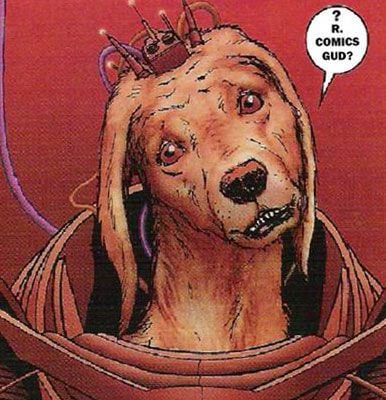


32 Comments:
I have a strong bias against uncolored comics, otherwise I'd scoop up more Essentials. They've gotta release color versions eventually, right? Right?
Apparently much of this stuff would have to be recolored, and Marvel figures it wouldn't be profitable to sell color paperback collections (as opposed to the pricey hardcover Masterworks). The hope that this'll change at some point is what holds me back from buying the Essentials, too.
Any chance you could move the graphics from this post to a host other than Geocities? They're all busted at the moment. I'd love to see 'em!
If we could even get greyscale it would be an improvement, but the problem with art that was originally in color is that the artist doesn't shade his work the same way since he figures the colorist will do a lot of the work for him. Thus when the coloring is taken away it's hard for me to differentiate figures and it all comes out looking confusing and flat for me.
Hopefully they eventually can scan and burn these books on DVD like they did for the 40 Years of FF DVD I just got.
Yeah, lemme see if I can move these suckers to Flickr or something.
Dagnabit.
I think these are the first Essential collections that I actually have all the original comics of!!!
Which means I will buy them again in this format just to make it easier to read!
Now if only DC would start putting out trade or Essential style books out for some of the Bronze Age horror titles...
My version of the joke, which I've been telling for decades now, is "I told this girl that if she came back to my place, I'd show her my Giant Sized Man Thing. Boy, was she disappointed to find out it was a comic book."
BTW, Howard the Duck #2 includes Gerber's dead-on parody of Don McGregor, which seems worth mentioning in this context!
How is Gene Colan underrated? Perhaps they made him wait a while to enter the Hall of Fame, but it seems to me that the majority of intelligent comics readers are fully aware of his greatness.
Okay, I think I got the pictures sorted. I'm not quite sure I'm using Flickr properly...it could be just that Geocities is having a good day.
Dang computers.
As far as Gene Colan, since I never hear him mentioned, I consider him "underrated." A personal call.
And yeah, Don McGregor, writer of most of Essential Killraven was satirized in Howard the Duck #2. He was the Space Turnip. The issue begins with a Killraven parody, then busts on the McGregor character's need to mythologize everything. Eventually he's hoodwinked by a turnip from outer space.
Good stuff.
I actually just read the entire run of The Defenders for my blog.
The Ganja powered Magician's name?
Cirus Black!
"a costume that lived on the corner of Cool Street and Goofy Bastard Avenue"
Brilliant. Effing brilliant.
So much fun stuff, so little money. I really like these Essential collections. Great for photocopying and letting the kids colour. Also good references for anyone thinking they want to start drawing comics.
Still, I'm a reader first and foremost so I think getting them in colour is a good thing. I'm still waiting for my Luke Cage collection in the mail.
HA!!
PICTURES FIXED!!
Sweet.
Great article. I am a newcomer to the Essentials line, but I have to say that they're pretty good values for the number of pages you get.
I must take exception with the comment on Gene Colan, where it's said that his art never seemed to fit well with superheroes. Colan's Iron Man is still the iconic version of the character, and with the possible exception of George Tuska, nobody's drawn him as well since.
My local comic shop had a bloody ream of Defenders in the quarter boxes, and I snatched them up for no apparent reason. The whole run is uneven, tries too hard to be either meaningful or weird for weird's sake, and pretty much tailspins in hard in the 80's.
That said, it would be cool to have Essentials of totally non-essential stuff, runs too short to collect anywhere else. The Warlock stuff could be padded out with his appearances in FF and Hulk; but I was thinking of randomness like Skull the Slayer or Omega the Unknown, both of which lasted like 8 issues. Marvel Chillers featuring Tigra. All those weird ones Marvel floated out there, looking for a hit.
I've been having lots of fun reading your blog (and grew up with the whack-out comics of the Seventies). I was going to send you the following item as an "urban legend" suggestion, but your article on Killraven makes it appropriate to post here:
"WAR OF THE WORLDS WEIRD FACT
In the 1970s, the original Planet of the Apes comic was published weekly in the UK, and proved a huge success. However, the weekly format soon meant the reprinted strips quickly caught up with the American monthly originals. To solve this problem, Marvel UK reprinted old "Killraven" strips -- a freedom fighter battling War of the Worlds Martians -- from Amazing Adventures."
"The art was altered so Killraven -- renamed "Apeslayer" -- was fighting apes instead of Martians."
From: Comics and Crumpets with John Freeman - December 15, 2004 (web) issue
(The web-site includes some examples of altered artwork)
The black & white art is a dealbreaker for me, as well.
It'd be nice if the Essentials volumes were available as DVDs or CD-ROMs, with color art.
Even if they needed to pay for coloring, they'd save money by not having to do pre-press or print four-color art.
Ideally, the B&W Essentials volumes would be accompanied by a DVD with the color art, but that's probably too much to hope for.
What is Breitling ? Do you know Breitling Watches ? Buy these Breitling Watches sale
on line.More cheap Breitling Watches for sale! Breitling replica Watches Please dicount Breitling Watches for yourself. Breitling Watch is your best friend. Breitling Watch sale
well.Looking these cheap Breitling Watch online. Because Breitling replica Watch is a wonder! So do please dicount Breitling Watch for youselves!!!
http://www.dofollowsocialbookmark.com/user/voted/hermes123
http://www.dubbagol.com/user/view/history/login/hoganscarpe111
http://www.indianpad.com/user/dvd321/voted
http://www.interdigg.com/user/view/history/login/hoganscarpe111
http://www.liputankhusus.com/user/history/hoganscarpe111
There are moments where I can't believe what marvel dared to publish. So lame characters, weak stories, and nothing in them was interesting enough to make up the weak characters.
Your blog is outrageous! I mean, Ive never been so entertained by anything in my life! Your vids are perfect for this. I mean, how did you manage to find something that matches your style of writing so well? Im really happy I started reading this today. Youve got a follower in me for sure!
nike air force
gucci belt
adidas ultra boost 3.0
golden goose outlet
falcons jersey
fitflops sale clearance
cheap jordan shoes
yeezy boost 350
http://www.uggoutlet.uk
nmd r1
hugo boss suits
ugg boots
gucci sito ufficiale
ugg boots
cheap basketball shoes
ugg outlet
saics running shoes
christian louboutin shoes
ugg outlet
pandora outlet
jordan shoes
adidas shoes
longchamp bags
golden goose sneakers
tory burch shoes
air max 90
100% real jordans for cheap
vibram fivefingers
lebron 13 shoes
ysl handbags
pandora outlet
cincinnati bengals jerseys
nba jerseys
michael kors handbags
cheap jordans
ferragamo outlet
ray ban sunglasses outlet
jordan 8
yeezy boost 350
philadelphia eagles jerseys
golden goose sneakers
yeezy
patriots jersey
adidas ultra boost
christian louboutin
nike kyrie 3
tory burch shoes
pandora charms
nhl jerseys
adidas superstar
49ers jersey
chrome hearts
nike shoes
bottega veneta
canada goose
ralph lauren outlet
san diego chargers jerseys
jaguars jersey
moncler outlet
los angeles lakers jerseys
zzzzz2018.4.28
chiefs jersey
canada goose outlet
detroit lions jerseys
bears jerseys
los angeles lakers jerseys
converse shoes
canada goose jackets
canada goose jackets
ray ban sunglasses
michael kors outlet online
nike shoes for men
ugg boots clearance
basketball shoes
ugg boots
nhl jerseys wholesale
polo ralph lauren outlet
pandora jewelry outlet
coach factory outlet
tory burch outlet
kate spade outlet online
www08/20
www0905
coach outlet online
christian louboutin shoes
coach outlet
canada goose jackets
ugg boots clearance
moncler outlet
red bottoms
tory burch outlet
adidas outlet
pandora charms outlet
آهنگ مرتضی اشرفی لجباز
آهنگهای پرسپولیس
آهنگ میثم ابراهیمی سلامتی
آهنگ حمید هیراد دلبر
آهنگ حسین توکلی امسال قشنگه
آهنگ محمد علیزاده گاندو
ریمیکس های جدید رادیو جوان
آهنگ اشوان آهنگ شاد
ترانه جدید mp3
موزیک Mp3
moncler outlet
off white t shirt
kyrie 7
yeezy 500
golden goose mid star
supreme clothing
golden goose
bape clothing
kd shoes
supreme sweatshirt
Post a Comment
<< Home